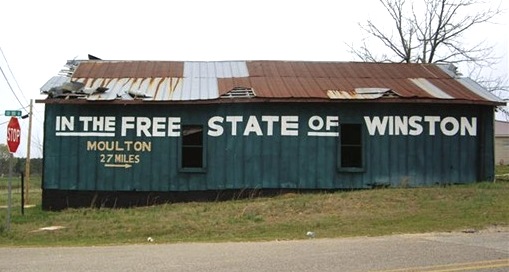
My roots are Southern. There are both Confederates and Unionists on my family tree. The Unionists are the ones I’ve spent five years trying to write a book about—complicated in more ways than I can express. They were a bunch of Northern Alabamans who wanted no part of Secession. Their county delegate to the January 1861 Alabama Secession Convention, a schoolteacher named Christopher Sheats, was beaten and jailed for refusing to sign the ordinance of secession.
These Winston County folks—led by my direct ancestors, the Curtis brothers—passed a resolution saying that if Alabama could secede from the Union, Winston County could secede from Alabama. Many Winston County men joined the Union army, including my 4th-great-grandfather, John Curtis. Others were killed in various gruesome ways by members of the Confederate Home Guard—their own neighbors. Another of my 4th-greats, one Wiley Tyler, died of starvation and infection in a Confederate prison camp. He’s where my pen name comes from.
I wish I could say that these devoted Unionist ancestors of mine—who fought and died because they refused to be traitors to their nation—had been passionate abolitionists. They weren’t. But they did know that the reason behind the War was slavery. Frank discussion of that reality is everywhere in their letters—just as it is in the letters written by the leaders of the Secession movement. In 1860 and early 1861, a number of men were appointed by various Southern states to be secession commissioners. These men traveled far and wide, speaking and writing in favor of Secession. You can read their letters. I have. They don’t beat around the bush. They believed that Lincoln was going to destroy the institution of slavery. You can read these letters—this primary source material—in a book called Apostles of Disunion.
When we get our information second-, third-, tenth-hand—when it comes to us filtered and packaged by people with something to sell—it can be difficult to get at the truth. The myth of the Lost Cause is one of those packages. The Confederate monuments, most of which were put up in the 20th century, long after the War—including many that were built in the 60s during the Civil Rights movement—are part of that mythology, that package. And it’s a package that was designed for and marketed explicitly to white people.
Those monuments celebrate men who went to war against the United States of America. Men who went to war because the Republic was finally moving to end the practice of enslaving other human beings.
Enslaving. Other. Human. Beings.
My friend Lydia Netzer wrote,
A statue of General Lee is NOT the same thing as a concentration camp turned into a museum.
A concentration camp turned into a museum would be like a slave market turned into a museum, or a slave plantation turned into a museum.
A statue of General Lee would be like if you tore down a concentration camp and left up a statue of Hermann Göring on a pedestal.
Removing these statues—moving them, perhaps, to a museum where these men’s own words could provide context on their intentions in declaring war against their own country—is in no way “erasing history.” We must not let pat phrases like that cheapen the way we talk about and think about these grave matters.
We must go deeper than the talking points. If you are bothered by the idea of history being “erased,” then READ that history—the primary source materials that clearly, directly, unequivocally laid out the reasons for the war in the first place.
Such as this address made by William Harris, a sitting Mississippi Supreme Court justice, to the Georgia state legislature, in his role as a secession commissioner:
“They [Lincoln’s Republicans and the North] have demanded, and now demand, equality between the white and negro races…equality in representation, equality in the right of suffrage, equality in the honors and emoluments of office, equality in the social circle, equality in the rights of matrimony…
“Our fathers made this a government for the white man, rejecting the negro, as an ignorant, inferior, barbarian race, incapable of self-government, and not, therefore, entitled to be associated with the white man upon terms of civil, political, or social equality…[Mississippi] had rather see the last of her race, men, women, and children, immolated in one common funeral pile [pyre], than see them subjected to the degradation of civil, political, and social equality with the negro race.”
The push to remove Confederate monuments isn’t an attempt to “erase” history. Quite the opposite. It’s an effort to expose the truth that has been papered over for far too long.
So I went to Alabama for research. I have volumes to tell about the trip—Scott says I could write a book about the writing of this book! I am working on a detailed account of the trip, but I will probably save most of it for when the book actually comes out. But for now, a few highlights.
We flew into Atlanta last Saturday night—or actually, it was early Sunday morning, I guess. Was nearly 2am by the time we reached our hotel. That’s only 11pm San Diego time, so it wasn’t too awful. On Sunday morning we met our friends Brian Stelfreeze and Stine Walsh for brunch at Ria’s Bluebird, which is now one of my Favorite Places to Eat, Ever.
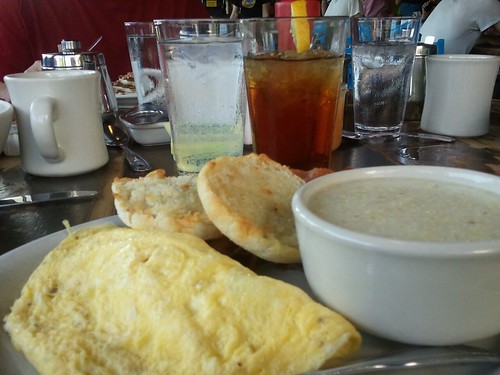
I could have eaten three bowls of those grits. The omelette was mushroom and fontina, if you’re like me and like to know as many details about people’s meals as possible. Also: homemade peach jam on those English muffins, and killer sweet tea.
We lingered long over our meal, and then lingered even longer in a baking parking lot talking to Brian and Stine, because we don’t get to see them that often and they are wonderful. I didn’t take any pictures! Unless you count my photo of a stinkbug on Brian’s shirt. What’s the matter with me?
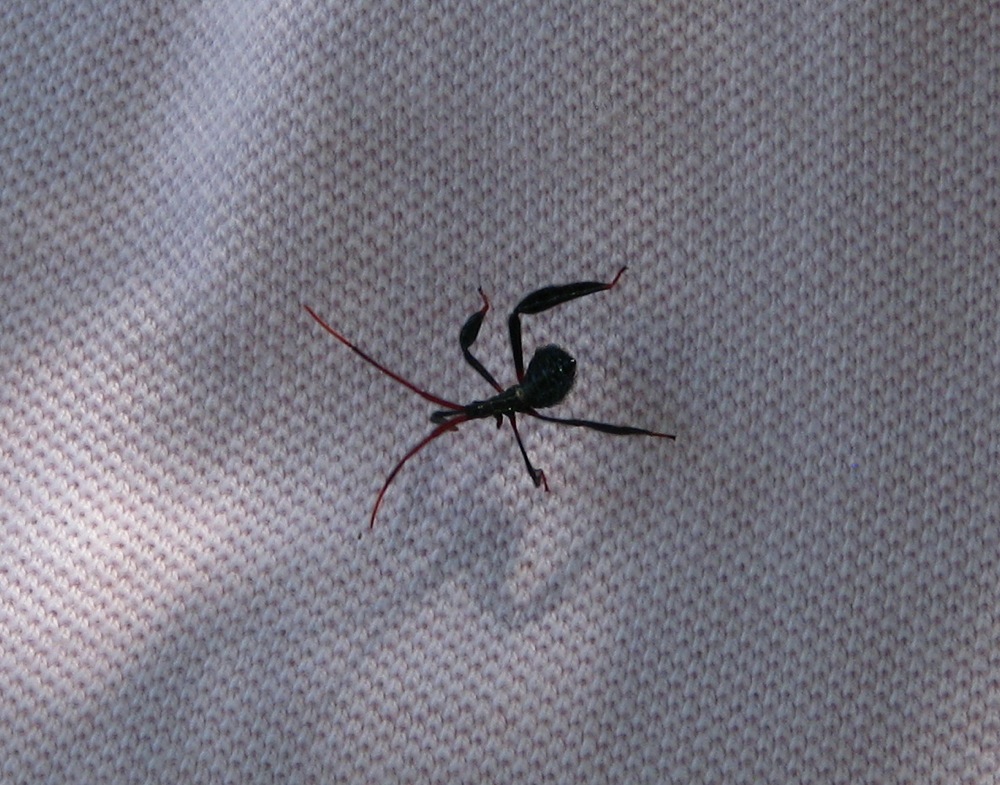
Eventually we dragged ourselves away and headed west. First stop: Hueytown, Alabama, just south of Birmingham to visit my Great-Aunt Cinderella and Great-Uncle Terrell. Yup, Cinderella is her real name—but you can call her Aunt Cindy.
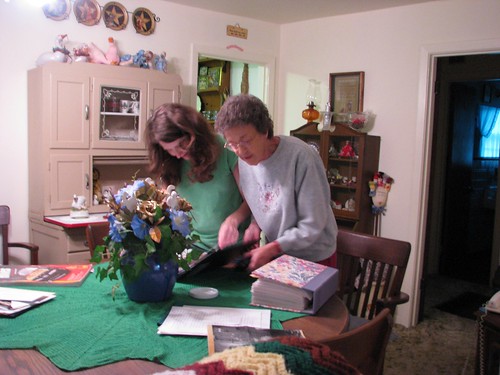
Aunt Cindy is my father’s aunt. Her older sister, Bettye, was the family genealogist and the person who first introduced me to the chapter of our family history that is the subject of my book. Aunt Cindy had her photo albums ready and waiting for me, and we spent several happy hours looking through them. She is a marvelous storyteller. This was to be a recurring delight on our trip—time with marvelous storytellers. I could have happily spent the whole week eating up Aunt Cindy’s stories. Uncle Terrell had some good ones of his own, too, but Scott had to tell them to me later because Aunt Cindy and I were talking a mile a minute.
All too soon we had to get back on the road. We wanted to reach our hotel before dark.
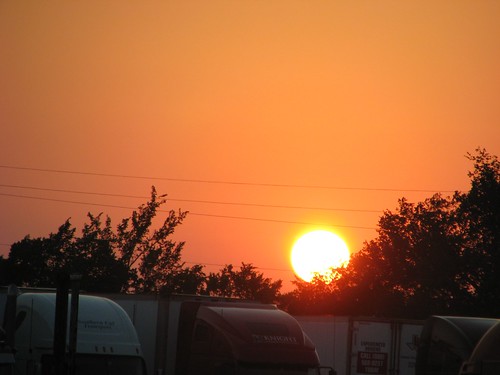
We stayed in [Small Town] but didn’t spend much time there. Our real destination was [I will tell you when I can]. First thing Monday morning, we drove to the County Archives in the heart of town. This county has a rich and unusual history in which my ancestors played a large part, and, well, that’s why I want to write about it, and I can’t wait until I can talk about it more openly. The incredibly nice folks at the Archives knew we were coming and were so kind to us all week, helping me look up information on old churches and schools and cemeteries and ancestors. And one day I will tell you all about where and what and who and why.

By an incredible stroke of luck, a distant relative of mine happened to be at the Archives when we first walked in. Of course, we didn’t know we were relatives right at first. I mentioned I was working on a certain branch of the family, and one of the archive volunteers said, “Oh, you need to talk to Darryal!” and motioned this kindly fellow over. He is a local historian and teller of fine tales, and one of the sweetest people you could ever hope to meet. Right away he offered to “carry us” to some cemeteries and other sites of relevance to my work. Not that morning—he was on his way to the funeral of his aunt who had died at the age of 105—but if we’d return the next morning, he’d be there.
Well. That was pretty exciting indeed. We spent the rest of Monday morning working in the Archives—my heroic husband spent at least an hour making photocopies for me—and then we moseyed down the street for a stunningly delicious meal at the local diner. (We liked it so much we ate there the next two days.) Best carrot cake I’ve ever had. (I liked it so much I ate it the next two days.)
After lunch we went out driving, exploring the area. Our wanderings took us through some of the tornado-ravaged towns I wrote about the other day. We also visited this old jail.
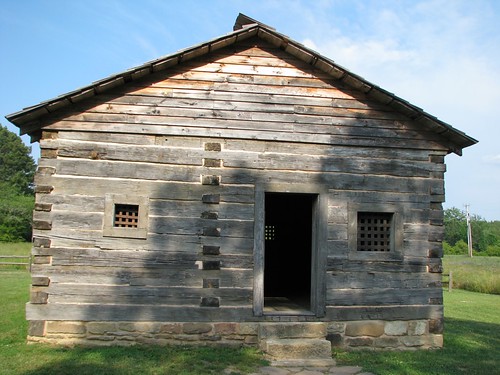
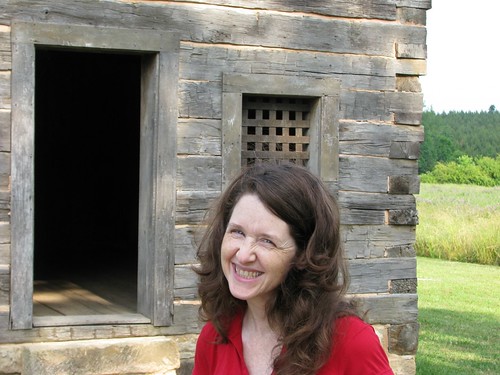
Bright and early Tuesday morning, we met up with Cousin Darryal (it’s pronounced Darrell) at the Archives. He climbed into our rental car and steered us toward the first of three cemeteries on our morning’s agenda. And this is where I could tell tons of stories, but I’m saving them for the book. Suffice it to say that Darryal is an expert on parts of the chapter of history I’m writing about, and we got along like gangbusters. He’s absolutely a kindred spirit—a real live Matthew Cuthbert. And he very generously gave us his entire day—amazing.
We quickly established our shared ancestry. His great-grandfather was the brother of my great-great-great-grandfather. The patriarch of one of the families I’m writing about is our mutual ancestor: Darryal’s 2nd-great, my 4th-great. (And also my 5th-great, due to a marriage of first cousins once removed a little on down the line).

The grave of one of the other brothers (there were nine of them altogether). Darryal is one of the people whose efforts keep these graves well tended and adorned with flowers.
It was kind of an emotional morning. These people I’ve been writing about, who have become so real to me, my great-great-greats and great-great-great-greats, there they were, their names on the stones. I’m kind of glossing over the real stories here, because I really do want to save them for the book. But it was quite something, seeing their graves and (later) walking on their land.
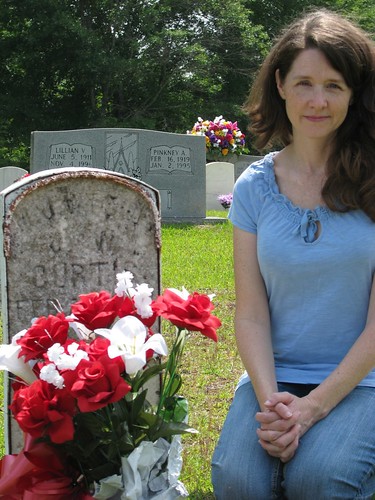
Darryal took us to see a creek bluff where one of my ancestors hid out for a while, and many other sites. And when I mentioned some of the other families I’m writing about, he said I needed to meet his buddy O’Neal, who—as it turns out—is ALSO my third cousin twice removed, but through an entirely different family line. He’s not kin to Darryal; they went to high school together. They both knew my father’s Aunt Bettye very well—“She was a dear friend to me,” said Darryal. “We dearly miss her.”
And so it came about that the next morning, we met Cousin Neal, and he took us on a tour of a whole different set of sites. We visited the cemetery where our mutual ancestor (again, his 2nd-great, my 4th-great) is buried, and then, O marvel of marvels!, he drove us right out to the spot where that ancestor homesteaded. I got to see where the house once stood, and we bumped down a steep branchy-slope-formerly-known-as-a-road to see the very spot in the river where the people in my book almost certainly swam and fished and swatted mosquitoes.
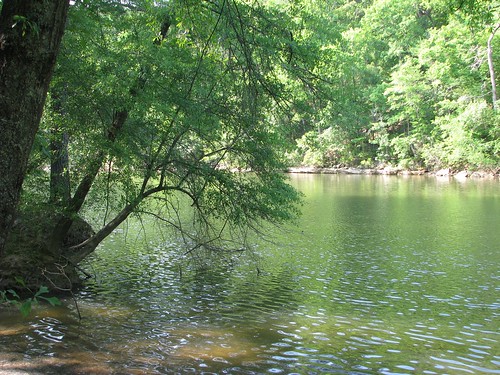
Cousin Neal is another born storyteller, with a deep and resonant voice, and a merry twinkle in his eye. He too gave us a full day of his time, even inviting us home to meet his wife Dot, where showed me some wonderful photos and even gave me some to keep. I could have stayed there a week, too.
Actually what I’d love to do is move my family there for the next year and write the novel in that beautiful hill country. I guess I’ll have to make do with going back someday—this time with the whole gang in tow, and my parents too. Perhaps when the book comes out.
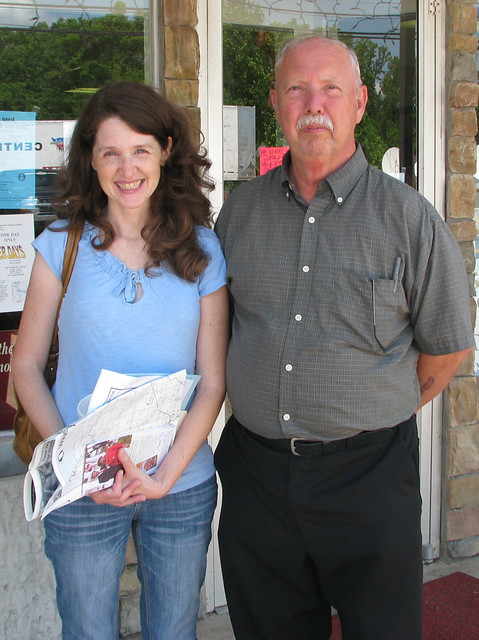
Cousin Darryal
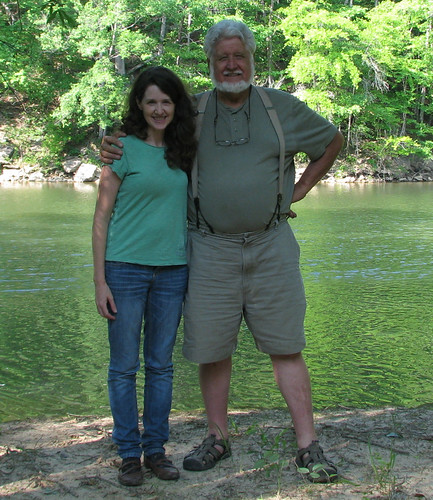
Cousin Neal













